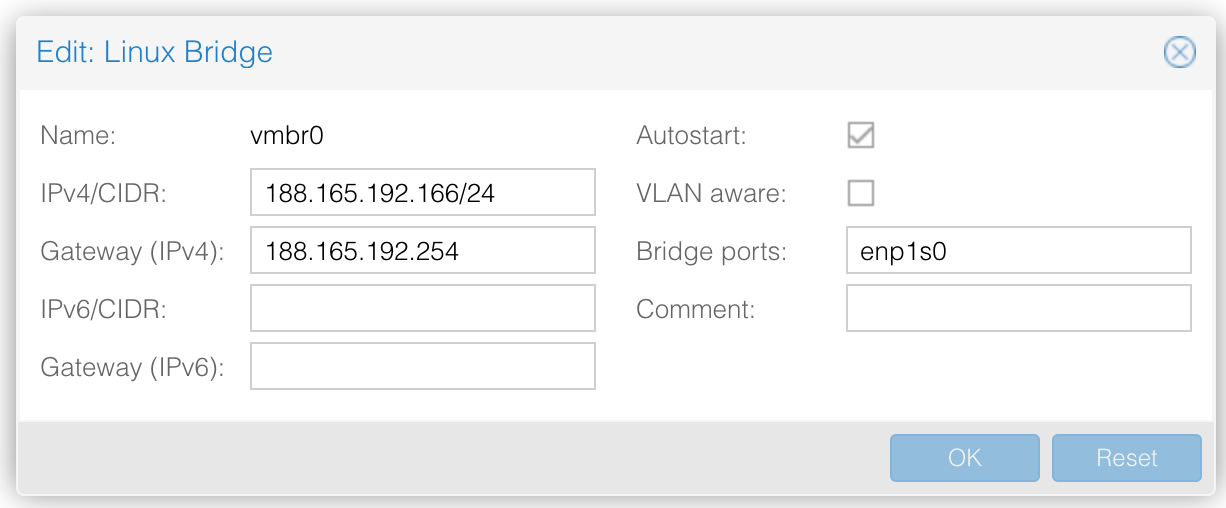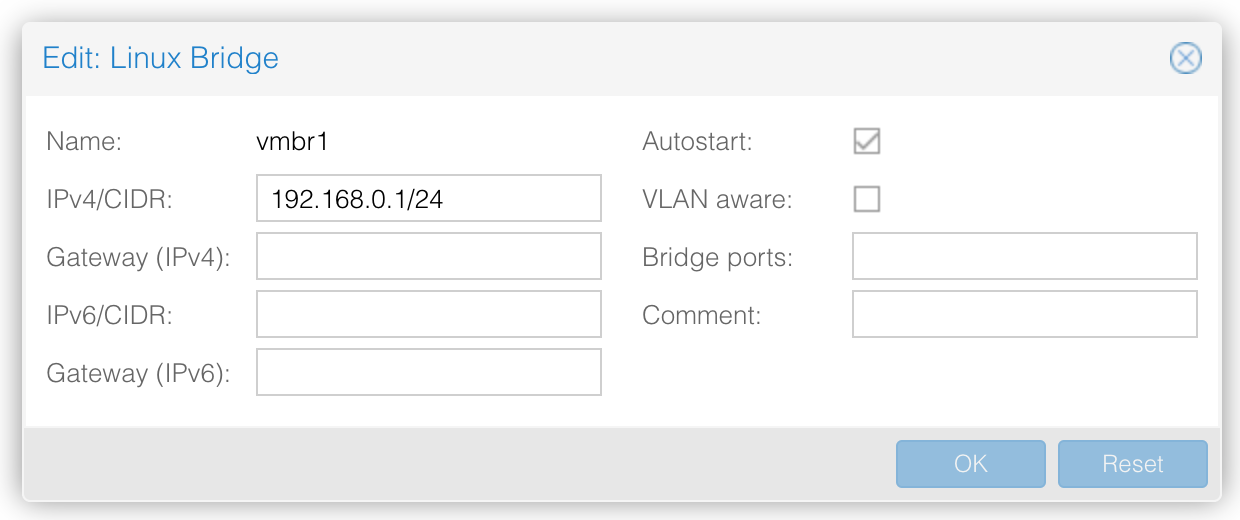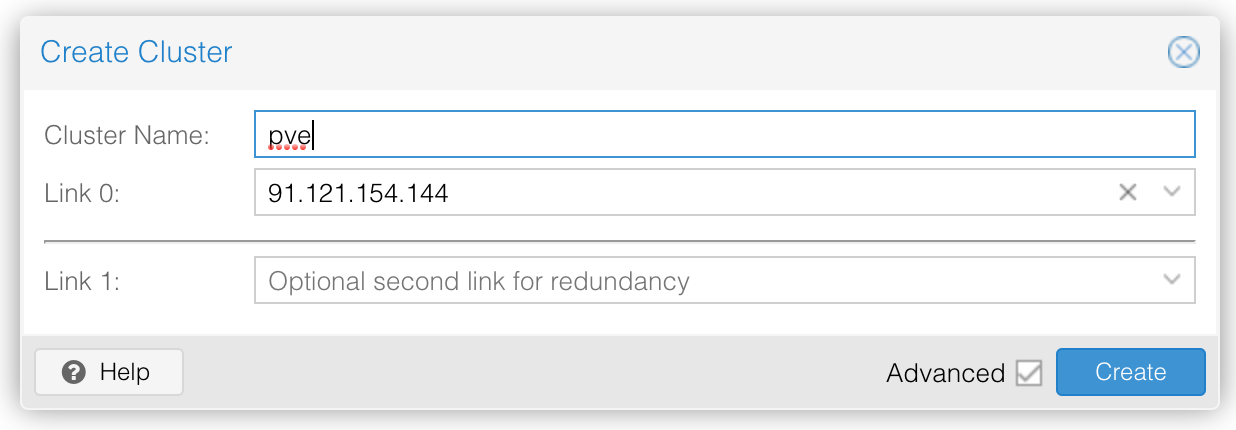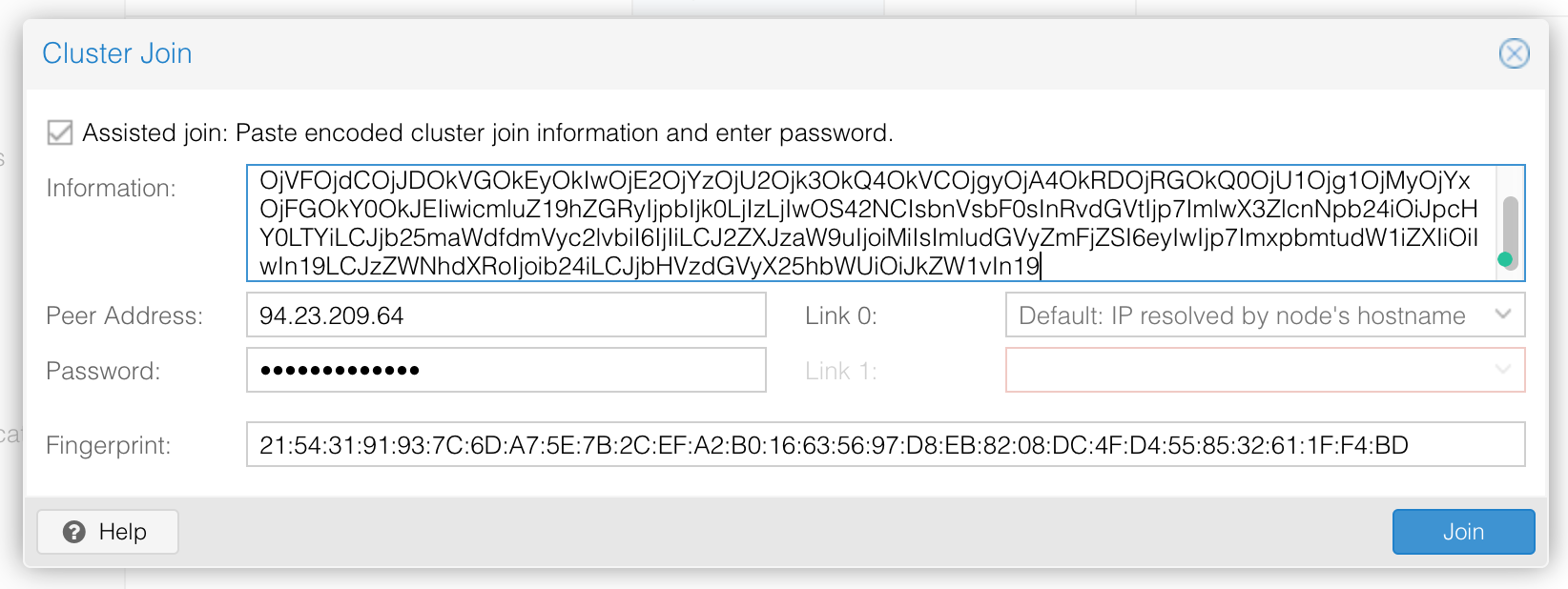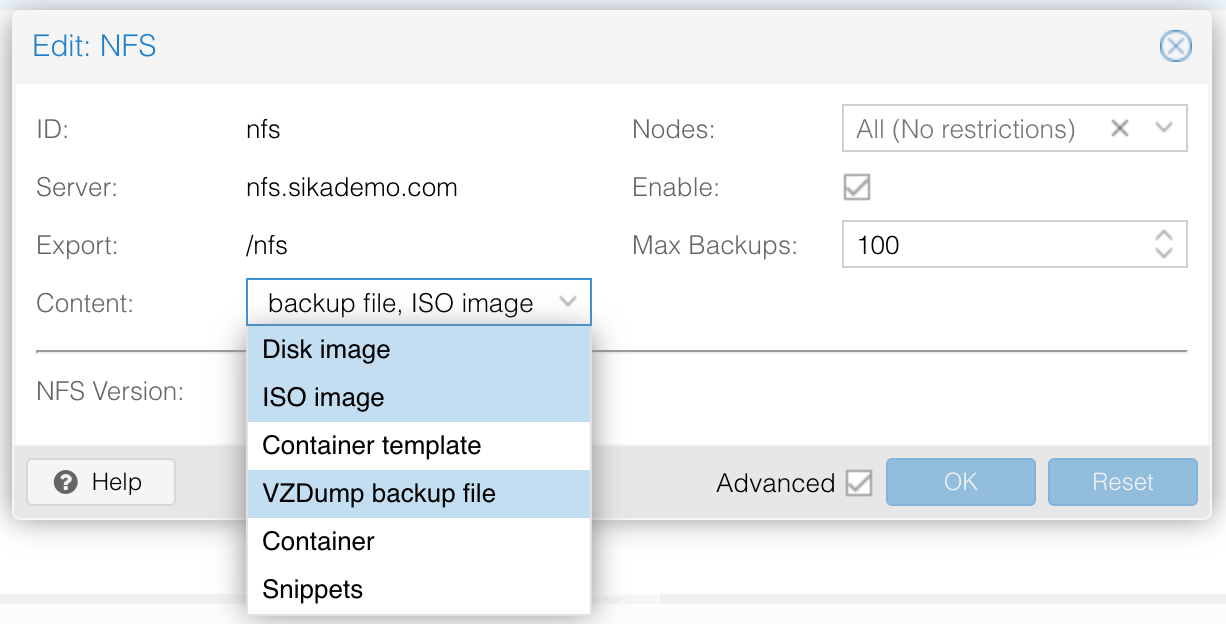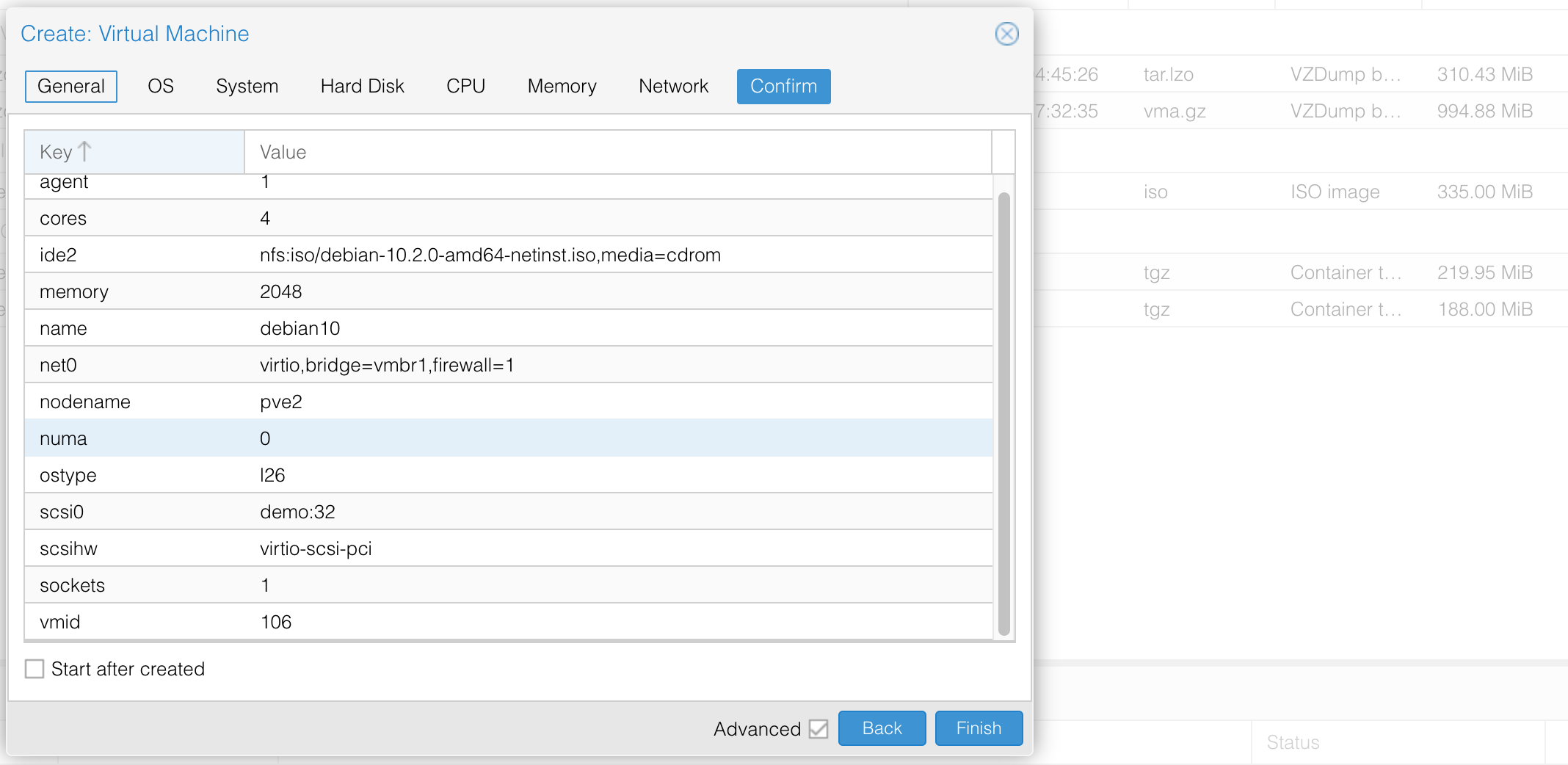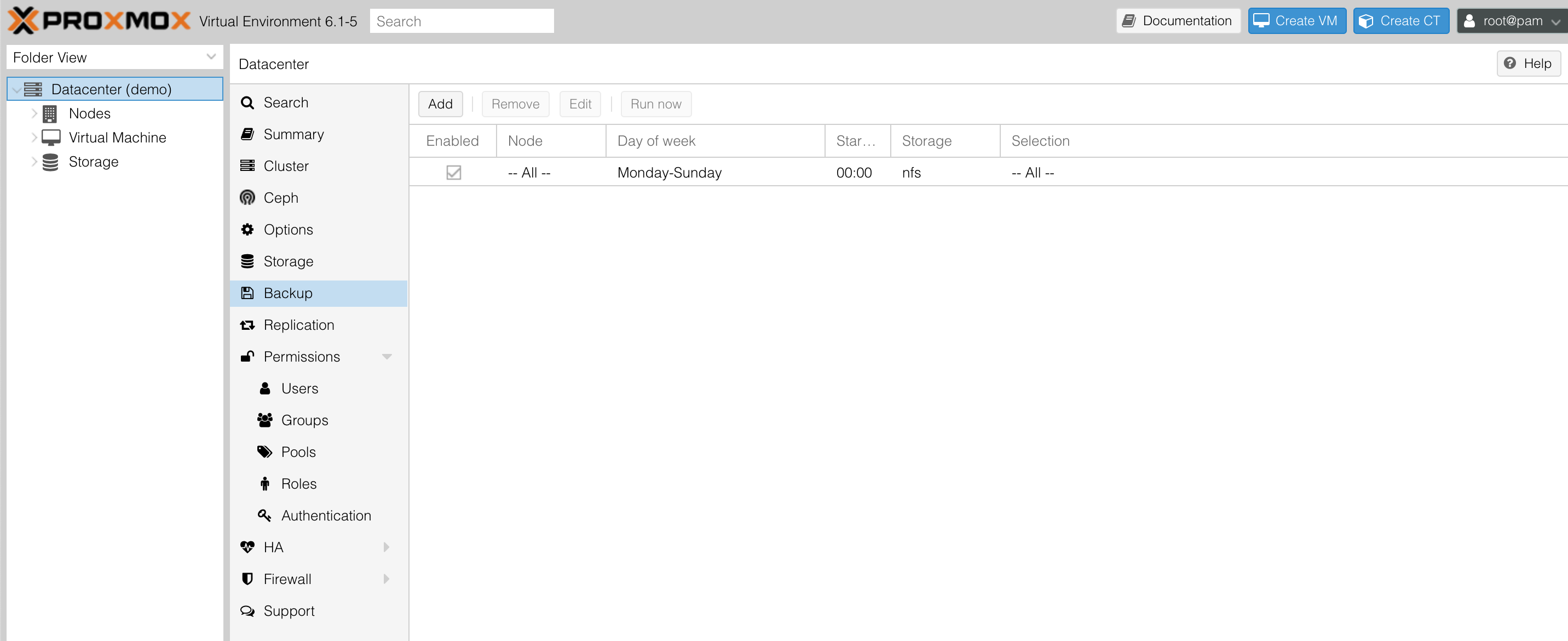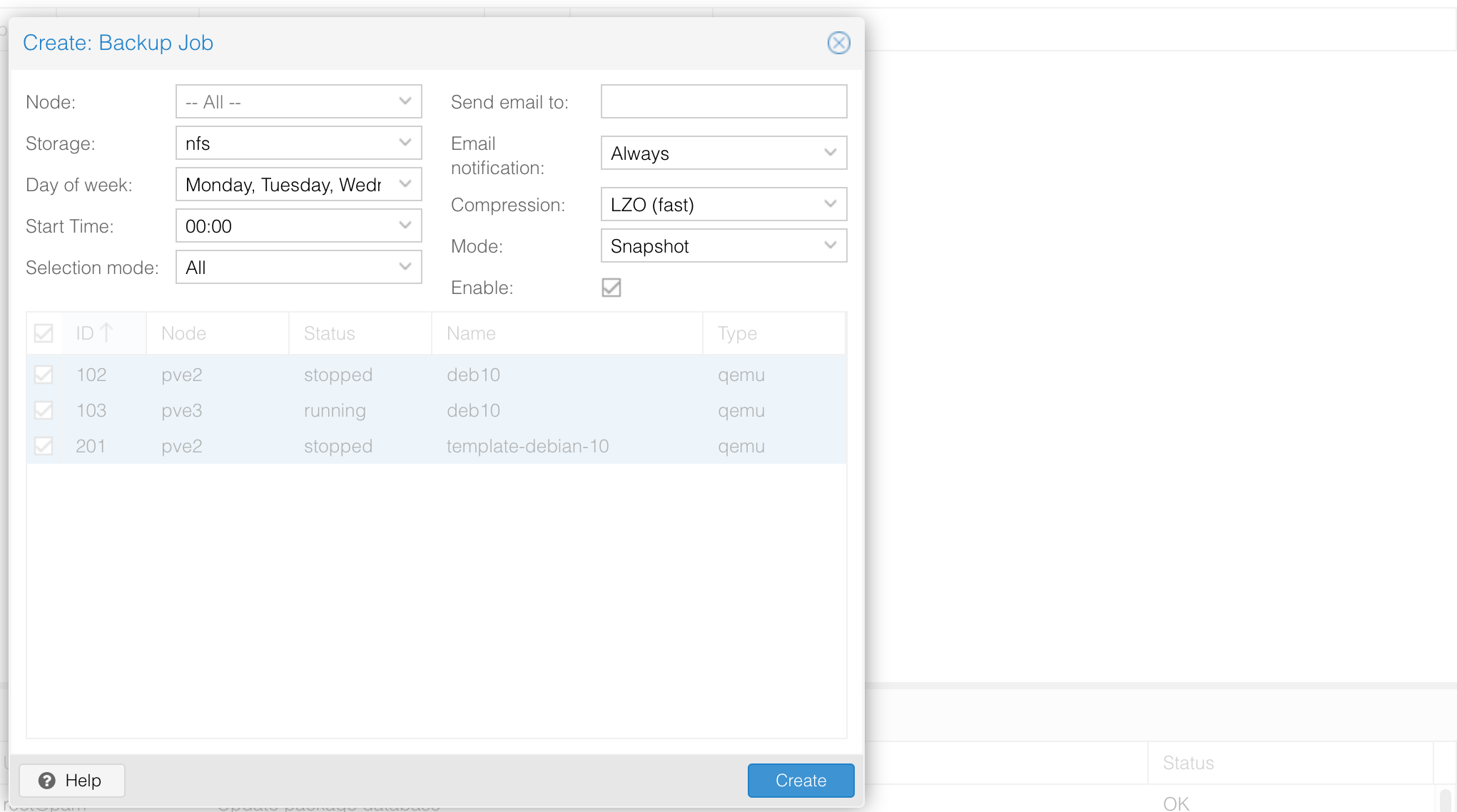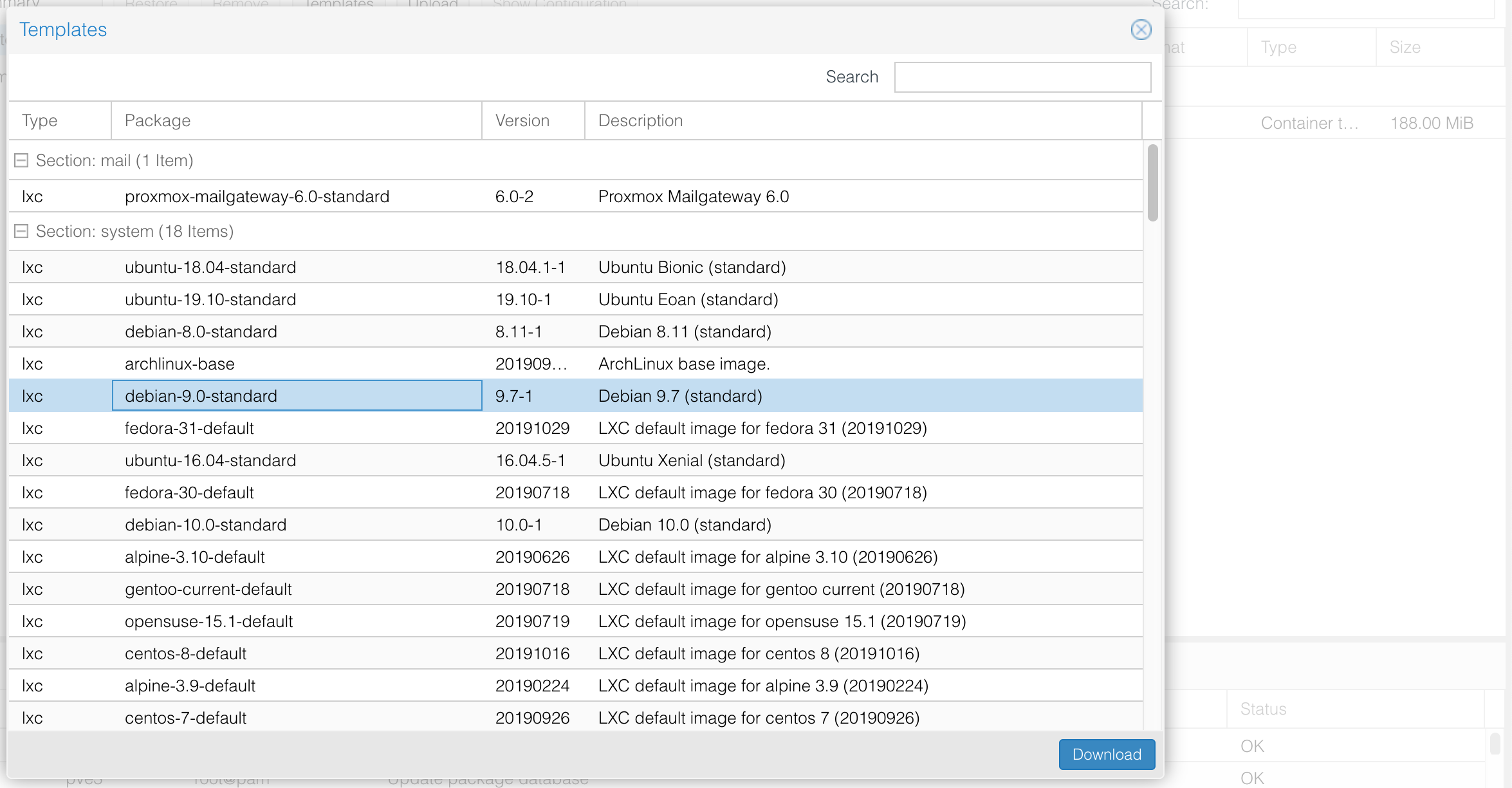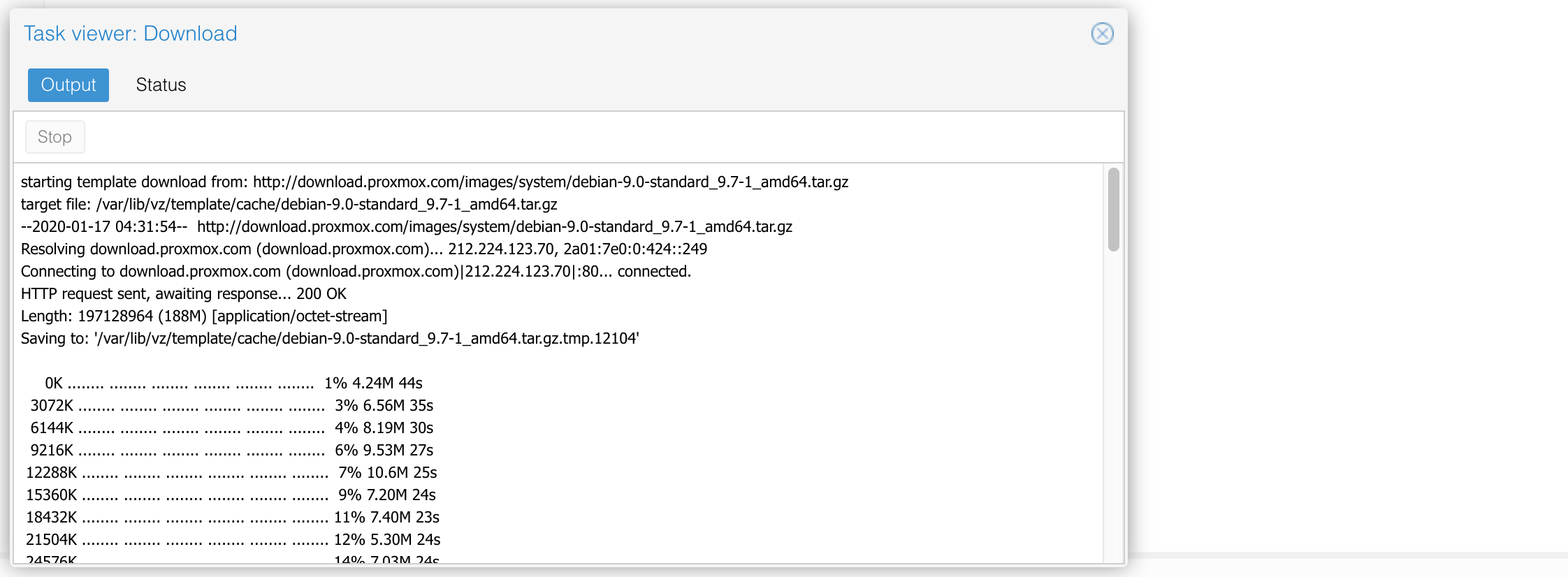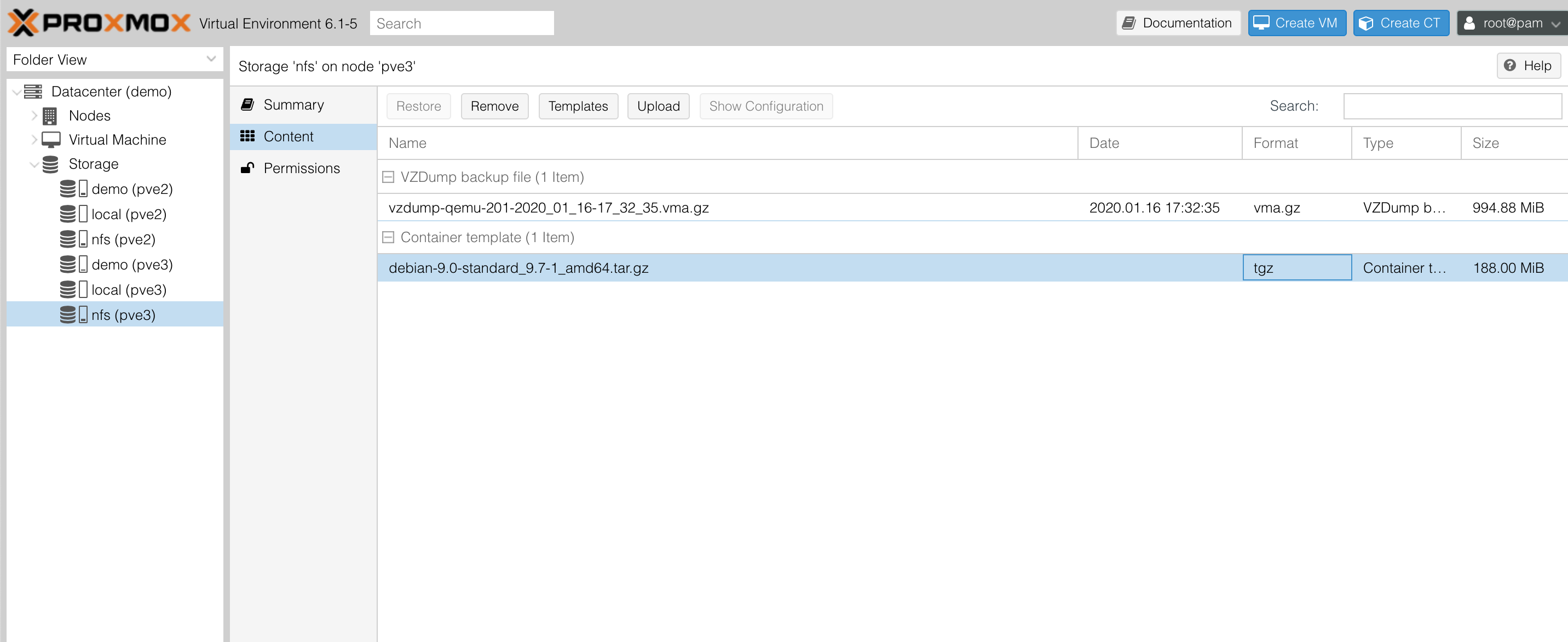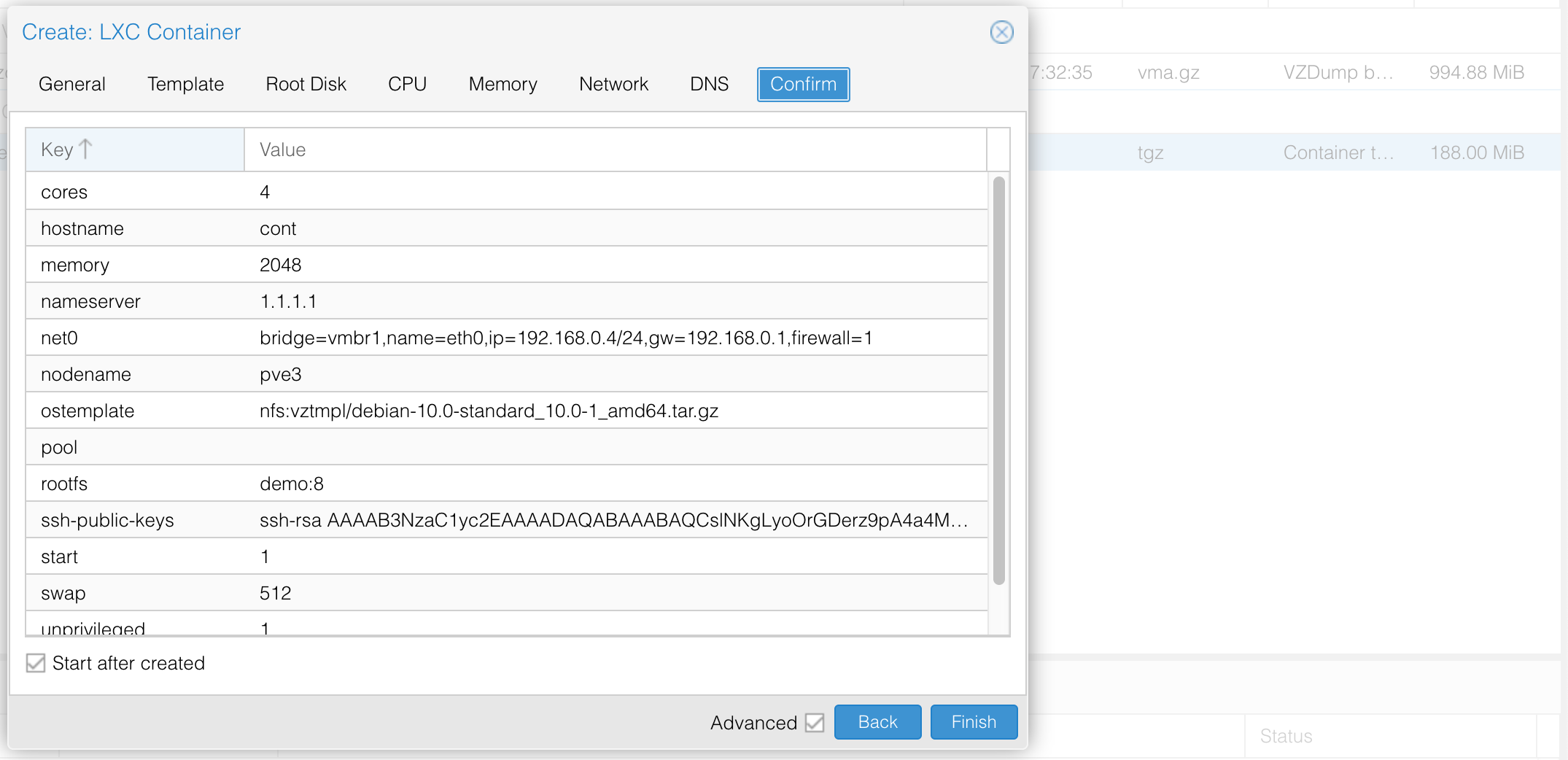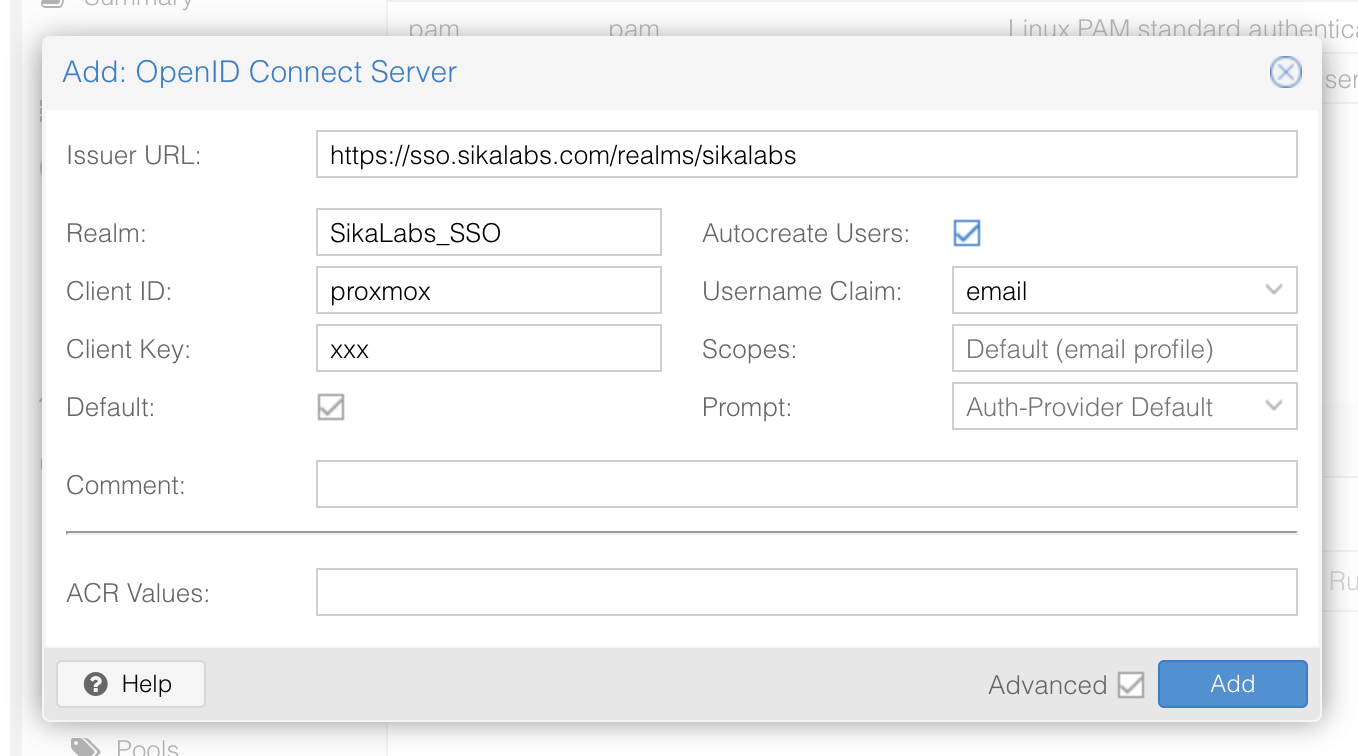Ondrej Sika (sika.io) | ondrej@sika.io | go to course ->
2019 Ondrej Sika <ondrej@ondrejsika.com>
https://github.com/ondrejsika/proxmox-training
DevOps Engineer, Consultant & Lecturer
Git, Gitlab, Gitlab CI, Docker, Kubernetes, Terraform, Prometheus, ELK / EFK
Feel free to star this repository or fork it.
If you find a bug, create an issue or pull request.
Also, feel free to propose improvements by creating issues.
For sharing links & "secrets".
- Slack - https://sikapublic.slack.com/
- Microsoft Teams
- https://sika.link/chat (tlk.io)
- Introduction to Virtualization, KVM & Proxmox
- Proxmox Node Setup
- Cluster Setup
- Storage
- Local
- NFS
- ZFS
- CEPH
- Virtual Machines
- Create VM
- Cloud Init
- Snapshots
- Backup / Restore
- Replication
- Migrations between Nodes
- LXC Containers
- Datacenter
- Scheduled Backups
- HA
- Permissions
- Prometheus Monitoring
- Beer!
- KVM & LXC Virtualization
- Web Interface, API, CLI & Terraform Support
- HA, Multi-Master
- Many storage plugins (NFS, CIFS, GlusterFS), built-in CEPH
LXC stands for Linux Containers and KVM is an acronym for Kernel-Based Virtual Machine. The main difference here is that virtual machines require their kernel instance to run while containers share the same kernel. However, each container still acts as its separate environment with their respective file systems.
In other words, containers are virtualization at operating-system-level whereas VMs is virtualization at the hardware level.
Terraform is infrastructure as a code provider. You can define your infrastructure in HCL (pseudo JSON) and apply it. Terraform makes your desired state (described in the file) to actual. More about Terraform on my website https://ondrej-sika.cz/terraform (CS only yet).
There is not official provider yet :'(
-
GUI:
-
Username:
root -
Password: you get a password at the course
- PVE - Proxmox Virtual Environment
- Node - Physical node which runs Proxmox & KVM
- VM - Virtual Machine
- CT - LXC Container
- SSL
- Network
- NAT
- Port Forwarding
You have to set up Let's Encrypt certificates on GUI proxy on port 8006
Go to Node (demo) -> System -> Certificates, setup domains & LE account and generate certificates.
You have to create the network for your VMs.
Go to Node (demo) -> System -> Network
Ensure static IP on default bridge (vmbr0) and bridged ports to an active network device (enp1s0).
Help:
# Get IP & Mask
ip a
# Get default route
ip route | grep default
Create a new bridge for VMs network.
If you have only one public IP address you have to set up NAT.
Create IP Tables rule on your node
iptables -t nat -A POSTROUTING -s '10.10.1.0/24' -o eth0 -j MASQUERADE
echo 1 > /proc/sys/net/ipv4/ip_forward
You can setup the SSH port forward into VMs
iptables -t nat -A PREROUTING -i eth0 -p tcp --dport 9900 -j DNAT --to 10.10.1.100:22
iptables -t nat -A PREROUTING -i eth0 -p tcp --dport 9901 -j DNAT --to 10.10.1.101:22
iptables -t nat -A PREROUTING -i eth0 -p tcp --dport 9902 -j DNAT --to 10.10.1.102:22
iptables -t nat -A PREROUTING -i eth0 -p tcp --dport 9903 -j DNAT --to 10.10.1.103:22
iptables -t nat -A PREROUTING -i eth0 -p tcp --dport 9904 -j DNAT --to 10.10.1.104:22
iptables -t nat -A PREROUTING -i eth0 -p tcp --dport 9905 -j DNAT --to 10.10.1.105:22
iptables -t nat -A PREROUTING -i eth0 -p tcp --dport 9906 -j DNAT --to 10.10.1.106:22
iptables -t nat -A PREROUTING -i eth0 -p tcp --dport 9907 -j DNAT --to 10.10.1.107:22
iptables -t nat -A PREROUTING -i eth0 -p tcp --dport 9908 -j DNAT --to 10.10.1.108:22
iptables -t nat -A PREROUTING -i eth0 -p tcp --dport 9909 -j DNAT --to 10.10.1.109:22
And Other ports, for example:
# HTTP & HTTPS to proxy VM (101)
iptables -t nat -A PREROUTING -i eth0 -p tcp --dport 80 -j DNAT --to 10.10.1.101:80
iptables -t nat -A PREROUTING -i eth0 -p tcp --dport 443 -j DNAT --to 10.10.1.101:443
# mail ports to mail VM (102)
iptables -t nat -A PREROUTING -i eth0 -p tcp --dport 25 -j DNAT --to 10.10.1.102:25
iptables -t nat -A PREROUTING -i eth0 -p tcp --dport 110 -j DNAT --to 10.10.1.102:110
iptables -t nat -A PREROUTING -i eth0 -p tcp --dport 143 -j DNAT --to 10.10.1.102:143
iptables -t nat -A PREROUTING -i eth0 -p tcp --dport 465 -j DNAT --to 10.10.1.102:465
iptables -t nat -A PREROUTING -i eth0 -p tcp --dport 587 -j DNAT --to 10.10.1.102:587
iptables -t nat -A PREROUTING -i eth0 -p tcp --dport 993 -j DNAT --to 10.10.1.102:993
iptables -t nat -A PREROUTING -i eth0 -p tcp --dport 995 -j DNAT --to 10.10.1.102:995
You need Proxmox Cluster for:
- CEPH
- HA
- Replication
Just a local directory on node's filesystem. You can store anything. You have to use qcow2 images for VM images.
- https://cdimage.debian.org/debian-cd/current/amd64/iso-cd/
- https://cdimage.debian.org/debian-cd/current/amd64/iso-cd/debian-12.1.0-amd64-netinst.iso
cd /var/lib/vz/template/iso/
wget https://cdimage.debian.org/debian-cd/current/amd64/iso-cd/debian-12.1.0-amd64-netinst.iso
mv debian-12.1.0-amd64-netinst.iso debian.iso
Run NFS server, for example nfs.sikademo.com (Terraform Manifest)
Got to Datacenter -> Storage and add NFS.
Now, you can store CD Images, Disk Images & Backups on NFC.
cp /var/lib/vz/template/iso/<iso_image> /mnt/pve/<storage_name>/template/iso/
Example
cp /var/lib/vz/template/iso/debian-11.5.0-amd64-netinst.iso /mnt/pve/nfs/template/iso/
Supports only VM & Container images (storage), no ISO and backups. You have to use raw images on ZFS.
Why Proxmox with ZFS:
- Replication between nodes (partial updates by
zfs send) - Easy Migration between nodes
ZFS Features:
- Snapshots
- ZFS Sync
ZFS Resources:
- https://pve.proxmox.com/wiki/ZFS_on_Linux
- https://www.howtoforge.com/tutorial/how-to-use-snapshots-clones-and-replication-in-zfs-on-linux/
Why Proxmox with Ceph:
- HA VMs
- Build-in Ceph Custer (easy setup)
Ceph is a open-source storage platform, implements object storage on a single distributed computer cluster, and provides interfaces for object-, block- and file-level storage. Ceph aims primarily for completely distributed operation without a single point of failure, and scalable to the exabyte level. -- wikipedia
- Ceph Intro & Architectural Overview (video) - https://www.youtube.com/watch?v=7I9uxoEhUdY
- Proxmox VE Ceph Benchmark 2018/02 - https://www.proxmox.com/en/downloads/item/proxmox-ve-ceph-benchmark
qm create <vmid> [ARGS]
Example
qm create 104 --cdrom local:iso/debian.iso --name demo --net0 virtio,bridge=vmbr0 --virtio0 local:10,format=qcow2 --bootdisk virtio0 --ostype l26 --memory 1024 --onboot no --sockets 1
apt-get install qemu-guest-agent
qm clone <sourcevmid> <targetvmid>
Example
qm clone 100 105
- Configure your VM on start
- Set root password
- Add SSH key
- Configure hostname & network
You have to have cloud-init installed in your template
apt-get install cloud-init
If you have cloud init installed, it will automatically run on every VM start.
/usr/sbin/qm snapshot <vmid> <snapshot name>
Example
/usr/sbin/qm snapshot 101 Snapshot_$(date +"%Y_%m_%d_%H_%M_%S")
For automatic (cron) snapshots, you can use https://github.com/kvaps/pve-autosnap
3 levels of consistency
- stop mode
- suspend mode
- snapshot mode
vzdump <vmid> [--mode <mode>] [--storage <storage>]
vzdump --all
Example
vzdump 100 --mode snapshot --storage nfs
qmrestore <file> <vmid>
Example
qmrestore 100 /mnt/pve/nfs/dump/vzdump-qemu-100-2019_11_29-06_29_48.vma
Requirements:
- Distributed (eg.: CEPH) storage or not replicated VM image - migration of replicated VMs is described below
Requirements:
- Proxmox Cluster
- ZFS Storage for VM image
Resources:
mv /etc/pve/nodes/<node>/qemu-server/<vm_id>.conf /etc/pve/nodes/<new node>/qemu-server/<vm_id>.conf
Example
mv /etc/pve/nodes/pve0node0/qemu-server/102.conf /etc/pve/nodes/pve0node1/qemu-server/102.conf
Go to Datacenter -> Backups
At first, you have to download the container template.
Go to Storage which supports Container Templates, for the example local or NFS.
Go to Create CT
Go to Datacenter -> Permissions
You can add permissions to other users, groups on VMs, Containers, Storage.
You can use resource pools to assign permissions (user, grout) to some resources.
- Create a group
- Create a pool
- Configure pool permissions
- Create users in Proxmox
- Create users in Linux (adduser)
- Add users to groups
- Create a resource in pool / Add resource to pool
- wakeful/pve_exporter (19 stars on Github)
- znerol/prometheus-pve-exporter (65 stars on Github)
Install
wget -O /usr/local/bin/pve_exporter https://github.com/wakeful/pve_exporter/releases/download/0.1.6/pve_exporter-linux-amd64 && chmod +x /usr/local/bin/pve_exporter
Run on the node
pve_exporter -password <password>
Run on the other machine
pve_exporter -pve-url <pve_url> -password <password>
Listen on port 9090
You need to have Prometheus installed
git clone https://github.com/ondrejsika/proxmox-training
cd proxmox-training
cd prometheus
# run Prometheus
prometheus
Go to http://127.0.0.1:9090/graph
That's it. Do you have any questions? Let's go for a beer!
- email: ondrej@sika.io
- web: https://sika.io
- twitter: @ondrejsika
- linkedin: /in/ondrejsika/
- Newsletter, Slack, Facebook & Linkedin Groups: https://join.sika.io
Do you like the course? Write me a recommendation on Twitter (with handle @ondrejsika) and LinkedIn (add me /in/ondrejsika and I'll send you Request for the recommendation). Thanks.
Wanna go for a beer or do some work together? Just book me :)
- Proxmox KVM - https://pve.proxmox.com/wiki/Qemu/KVM_Virtual_Machines
- Proxmox Command Line Tools - https://pve.proxmox.com/wiki/Command_line_tools
- Backup & Restore - https://pve.proxmox.com/wiki/Backup_and_Restore
- Cloud Init - https://pve.proxmox.com/wiki/Cloud-Init_Support
- Cloud Init FAQ - https://pve.proxmox.com/wiki/Cloud-Init_FAQ
- Proxmox on Single IP Address - https://www.guyatic.net/2017/04/10/configuring-proxmox-ovh-kimsufi-server-single-public-ip/
- Persistent IP Tables Rules - https://www.thomas-krenn.com/en/wiki/Saving_Iptables_Firewall_Rules_Permanently
- Install Proxmox on Debian - https://computingforgeeks.com/how-to-install-proxmox-ve-on-debian/
- Upgrade from 5.x to 6.0 - https://pve.proxmox.com/wiki/Upgrade_from_5.x_to_6.0
- ZFS on Linux (Proxmox Wiki) - https://pve.proxmox.com/wiki/ZFS_on_Linux
- Snapshots, Clones & Replication in ZFS on Linux - https://www.howtoforge.com/tutorial/how-to-use-snapshots-clones-and-replication-in-zfs-on-linux/
- Proxmox VE Ceph Benchmark 2018/02 - https://www.proxmox.com/en/downloads/item/proxmox-ve-ceph-benchmark
- Ceph Intro & Architectural Overview (video) - https://www.youtube.com/watch?v=7I9uxoEhUdY

